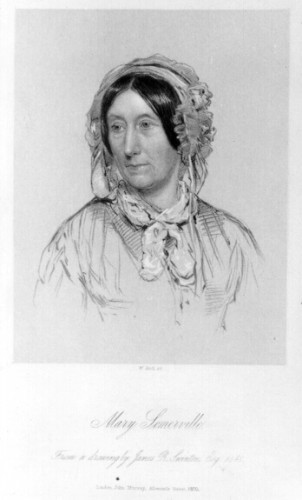At the beginning of the 19th century, the idea of presenting scientific concepts to the general public, and publishing books and journals on scientific subjects, for non-scientists, did not exist.

Marie Somerville (1780 – 1872) is considered the pioneer of popular science literature. At the beginning of the 19th century, the idea of presenting scientific concepts to the general public, and publishing books and journals on scientific subjects, for non-scientists, did not exist. In 1834 (during the "Golden Age" of English literature, in which the books of Lord Byron, Sir Walter Scott and Jane Austen were published) Somerville published the first edition of her book On the Connexion of the Physical Sciences the physical ones) who described in clear language, without formulas, with few graphs and some mathematics, main concepts in different fields of science: astronomy, physics, chemistry, geography, meteorology and electromagnetism. This book was the best-selling scientific publication for 25 years (until the appearance of Charles Darwin's book "The Origin of Species"), it was published in 10 editions and was translated into French, Italian and German, and was also published in the USA.
Marie Fairfax was the daughter of a Scottish admiral, and lived by the seashore, where she spent most of her time until the age of 15, watching seabirds and collecting shells. One day a magazine that dealt specifically with fashion rolled into her hands, and for some reason an algebraic equation was mentioned in it. This ignited her curiosity, and she began to study the writings of Euclid and Newton; She continued to study mathematics, while at the same time playing the piano and painting. After being widowed from her first husband at a young age, she remarried to doctor William Somerville, and in 1816 she moved to live with him and their children in London, and then first became acquainted with the world of British science, which was at the beginning of the discovery period of the 19th century: among her friends were the drafter of the laws of electromagnetism, Michael Faraday, the astronomer William Herschel, calculator developer Charles Babbage and others. At that time, the first scientific societies began to be organized in Great Britain, and at the invitation of one of them, she wrote her first scientific work in 1830, a translation of the French mathematician Laplace's book "On the Mechanics of the Sky". Following her work and in preparation for writing her famous book, she made a long visit to Paris, where she got to know the work of the French physicists Ampere and Becquerel and the chemist Ga-Lissac.
Her book, which was written over about four years, explained, among other things, the laws of gravitation, magnetism, acoustics (through explanations of wave motion), the spectrum of light waves and the laws of electromagnetism, shortly after Faraday discovered them. She also described major research expeditions conducted up to that time (such as those of Sir John Franklin to the arctic regions, and hot air balloon flights in which Ga-Lissac participated) and linked them to the various fields of science (hence the name of the book). James Clerk Maxwell, who formulated the famous electromagnetic equations based on Faraday's discoveries, described her book as "describing in a definite, intelligent and comprehensible manner the guiding ideas operating in the minds of scientists".
A year after the publication of her book, Marie Somerville was one of the first two women to be admitted as members of the British Astronomical Society, along with Caroline Herschel, the sister and research partner of Sir William Herschel. In addition, she was active for women's rights, against slavery in the USA and for the prevention of cruel experiments on animals.
For an article in the journal Nature
